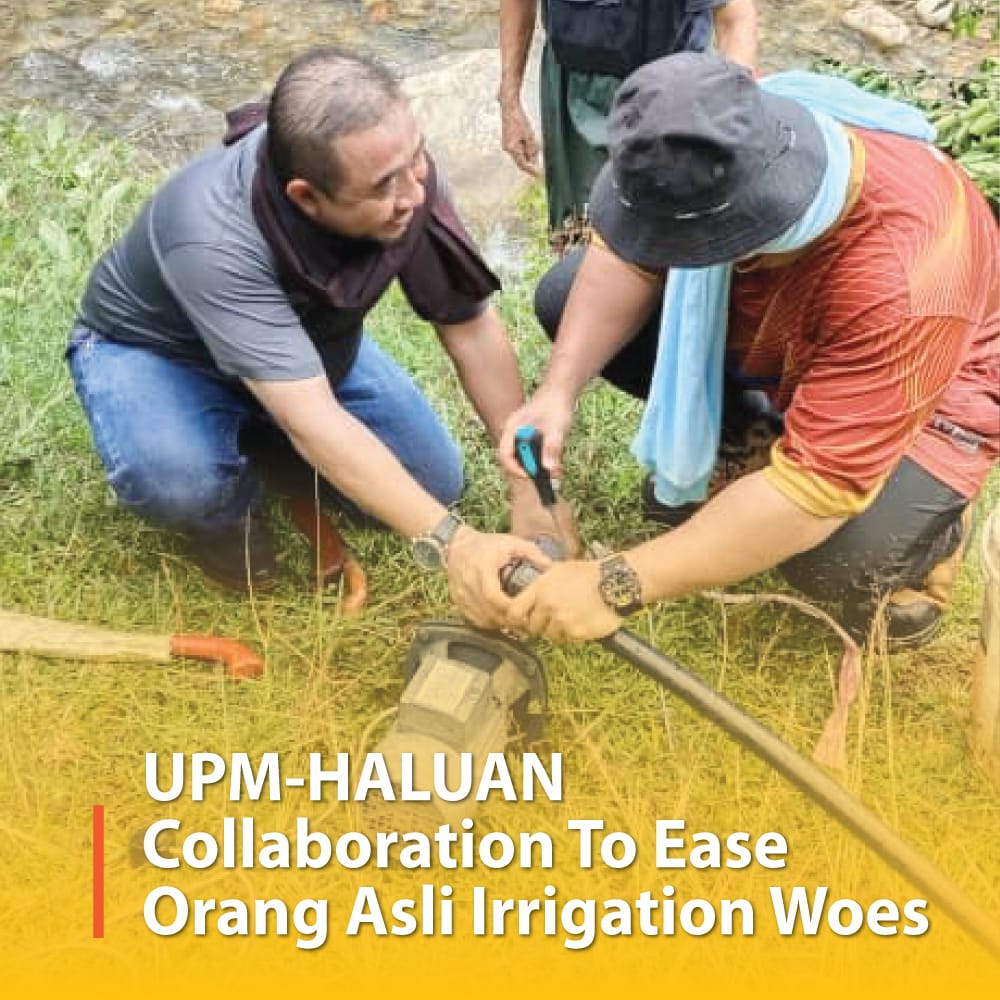
UPM-HALUAN Collaboration To Ease Orang Asli Irrigation Woes
AIR BANUN, GERIK, 26 May 2025 – Imagine having a river just beside an orchard but the plants thirst for water. That is the sad scenario of orang asli farmers tending to their little plot of lime and lemon grass. Situated 20 feet above a levee, the scooping of water using used empty 10 gallon paint pails proved too ardous a task for these farmers in their 40s and 50s to keep watering the plants especially during hot sunny months.
“We are thankful that HALUAN has built us a shed and provided us with a diesel water pump over a year ago. Least we don’t have to manually scoop water and hike up anymore using our bare hands and feet. It is taking a toll on us at the acreage. And this latest endeavour through their cooperation with Universiti Putra Malaysia (UPM) promises to be a blessed alternative at irrigating,” says orang asli farmer, Sani Dalong who has taken over the orchard from his ageing father of 72.
UPM has embarked on a plan to utilise modern technology to irrigate the orchard utilising a time-controlled solar-powered electric water pump. That little shed facilitates but is just the tip of the iceberg. There are lots more to understand and execute before it becomes a reality.
Project head honcho, Dr. Muhammad Saufi Mohd Kassim from the university’s agriculture mechanisation and automation section of the Department of Biological and Agricultural Engineering under UPM’s Faculty of Engineering brought over a prototype model to test at site with the aid of three of his final year students. Their verdict after several trials – it is going to work. The sprinklers spun powerful streams and churned fresh clean river water 20 metres around, enough to irrigate the 60-odd lime trees and lemon grass the orang asli planted over nine years ago in phases.
Affable Dr. Saufi was very forthcoming and patient when asked layman questions on how this works.
“It all started over a year ago through some presumptions we made from afar when we got the pictures taken by a preceding UPM team. We were thinking of enabling irrigation plus fertilisation simultaneously via drip lines at each tree. But after visiting the site proper months back, we changed our module to fit the terrain and the manner by which the orang asli planted the trees, not quite in an orderly manner. We took soil samples and found that to be at equilibrium throughout the orchard. Then we sat down to think out how to irrigate at this height from the river level. We recalculated matters like the elevation, the size of the water pump, the volume of desired water flow, and also HALUAN’s request for a solar powered pump system. So we have to go back to the drawing board on this. And after adjustments and trials in campus, we are quite pleased with the outcome,” said the lecturer.
The trapezium plot measures 83 metres long running along the length of the river and a breadth between 18 to 20 metres. The pump required was not too big and the re-engineering requires about eight sprinklers for the entire orchard standing at about a foot tall, and a distance of 10 metres in between each sprinkler. The radial outreach per sprinkler is 10 metres covering 20 metres of spray in each swivel. The pump will operate automatically employing a timer mechanism powered by a solar panel system and an inverter to charge up the battery. The don said proper calculations are necessary to enable the optimum operation of the pump which is dependent upon the wattage produced. Each of these components have a lifespan of about two years before the inverter, charge controller and battery fail, requiring replacement. Intensive heat or high humidity can also affect the apparatus involved requiring the use of ventilators and dehumidifiers.
The three accompanying UPM students were deeply immersed in the project, getting as wet as Dr. Saufi while testing out the spray pump. Two of the undergraduates are in their final semester while the post-graduate student, all of them in agricultural engineering stream, is completing his final year project in mechanisation of pineapple fertilisation using remote mechanisation technology.
Project lead student, Kalif Conder who is pursuing a bachelors degree in agricultural and biosystems engineering is optimistic and hopeful that the project will be a success. “What we learn from classes we want to bring them to fruition here and hence creating a positive impact on the community. Personally I am happy to be with this team and I feel this knowledge that we are gaining is not wasted. Out here it is a totally different environment for us students. This particular breakaway topic that takes us far away from our campus becomes the most clamoured topic amongst our 42 colleagues in class. Almost everyone wants ‘in’.”
Dr Saufi added that those admitted under this topic are selected. The other 2 topics revolved around Selangor.
What is Dr. Saufi’s personal endeavour in this? “You have a (agricultural) issue or problem, we (the university) will try to provide the solution. When we can assist in solving your issues, the dire need for auto irrigation can be achieved albeit some modifications. Another aspect of this is self fulfillment and elation that we at UPM are able to extend technology to those in need especially the aborigines. Importantly, we can educate our students in a deeper sense, to be hands-on and help expose them to real life challenges faced by farmers. We carry the name of our institution and we welcome future challenges that the agricultural sector faces in hopes of better solutions.”
Meanwhile. HALUAN’s welfare bureau chief, Mr Abdul Halim Khudri hopes this collaboration with UPM will open avenues for more such projects with other universities too. “We hope these institutions can seek out funding and grants for an NGO like us to tap into for projects that will benefit communities here and abroad. Not just for agriculture but the works. In fact here in Air Banun we are looking for funders to reboot our roselle plantation project that has stalled for many months now”.
Dr. Saufi revealed that 13 of his undergraduate charges will be arriving at Air Banun from the 19th to 22nd of June to physically install and test the complete solar powered irrigation system as part of their final year graduation prerequisite. They would set up the irrigation apparatus first followed by the installation of the solar panel system on the second day. On the third day, they will proceed to lay the main pipe for the sprinklers, and conduct a trial run and troubleshooting of the installed system. HALUAN is deeply indebted to UPM in jointly facilitating this project that will assist the marginalised community of aborigines deep in Belum Forest.








Report by MediaHALUAN


